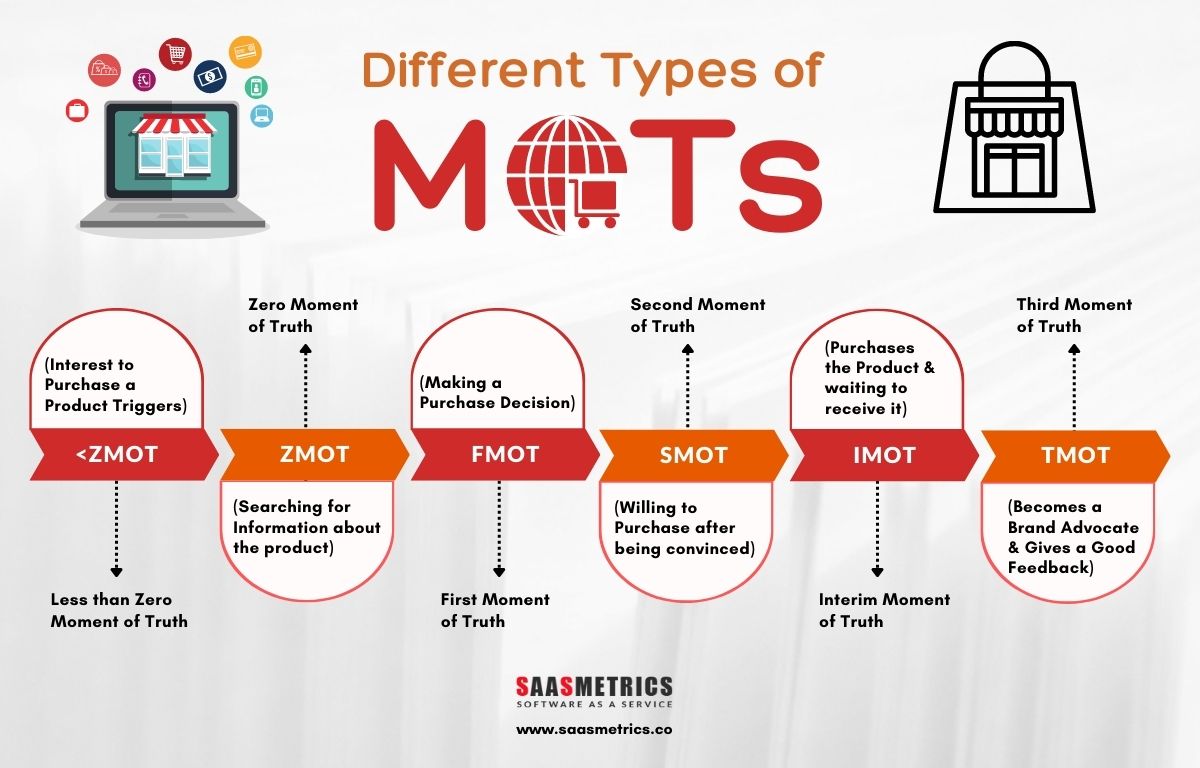Moment of truth (MOT) is a concept in marketing that refers to the instant when a customer decides whether or not to buy a product. It can also be referred to as the point of purchase. The term was originally used by retailers and wholesalers but has since been adopted by many other industries, including travel agents, airlines, restaurants, and hotels.
In the first few seconds, after a customer sees an advertisement for a product, they decide whether or not it’s worth their time to read further. If they decide it isn’t worth it, they will leave the website and never return. This is why it’s so important for businesses to ensure that their websites are user-friendly and easy to navigate if they want customers to stay on their pages long enough to complete their purchases.
Different Types of MOTs
1. Less than Zero Moment of Truth (<ZMOT)
A customer’s interest in making a purchase is triggered by an event, such as seeing an advertisement or being approached by a salesperson.
2. Zero Moment of Truth (ZMOT)
The customer begins the purchasing process by researching a product.
3. First Moment of Truth (FMOT)
Also known as the awareness phase, the moment when a customer first learns about your product or service. This can happen in various ways, including through articles on your website or social media. But now it’s time for the customer to experience your product in person: Does the customer continue with his purchase, or will he walk away?
4. Second Moment of Truth (SMOT)
After the customer sees a demonstration or uses the product, she is convinced. She thinks: Can it really deliver on its promises? She looks more into your website and finds interesting case studies or application examples that eliminate any doubts.
In the past, people often made purchase decisions before actually taking delivery of their goods; today, however, the rise of online purchases has changed this pattern. Now customers often wait to receive a product before deciding whether to keep it.
5. Interim Moment of Truth (IMOT)
The time period begins when a customer purchases a product and ends when he receives it. It is also called the Absolute Moment of Truth (AMOT).
6. Third Moment of Truth (TMOT)
After a customer chooses your product and completes the purchase, there is one last aspect of the Customer Journey to look forward to: Feedback. Your customers will tell others about their experience with your product, whether that be in person or through social media.
The point at which different moments of the customer journey occur depends on numerous factors, particularly the industry and type of business. Each target group perceives different points differently, so it is crucial to identify them. All customer journeys have at least one thing in common: The importance of digital marketing and customers’ growing preference for researching services online before making a purchase.
How to Improve Your Customers’ Moments of Truth
Before learning how to improve your customer’s moments of truth, you need to know how brands fail at meeting customer expectations:
-
Poor Product Quality
This is especially important for e-commerce businesses selling physical goods online.
-
Bad Delivery Times
If your customers don’t receive their order within the expected timeframe, then they will not be happy with their experience and will likely not come back again.
-
Inefficient Customer Service
Poor customer service can lead to a number of issues, including unhappy customers and negative reviews online.
Here are some ways how you can improve your customer’s moments of truth:
- Know your customers and how they want to be treated.
- Create a culture of service excellence across all areas of your business.
- Create consistent experiences for every touchpoint along their journey that keeps them coming back again and again.
- Ensure that your website is easy to navigate. This can be accomplished by having a simple design and clear navigation throughout your site. Make sure all links work properly too! Your customers should be able to find what they need with just one click – no more than two clicks at most!
- Provide good customer service and support.
- Inspect your products before selling them. If there are any defects, don’t sell them — it could mean losing a customer who returns later without knowing what happened.
- Train employees on how to answer questions about products and services so they don’t have to waste time looking up answers themselves or passing along questions to someone else who might not know either.
- Make sure there are plenty of staff members available during busy times so customers won’t have to wait long for help or assistance with finding items in-store or online (if applicable).
What is Moment of Joy (MOJ)?
The experience of joy is universally human. JOY can come from an array of experiences, including moments of delight and pleasure, as well as success and accomplishment.
People find joy in different ways, but for most people, it comes from family, friends, and new experiences. The simple things in life like washing dishes or shopping online can give us the most meaning. This means being mindful of the present moment and doing what you love.
We often fail to appreciate the importance of the present moment until it is past.
Difference between MOT and MOJ
MOT is a moment of truth. It’s a crucial point in which a customer decides whether or not to buy your product. If MOT is good, you’re golden. If it isn’t, then you lose the customer.
MOJ is a moment of joy. It’s when the customer gets your product, uses it, and loves it.
The Moment of Truth is the point in the customer journey where you have earned their trust, confidence, and loyalty. In other words, it’s when they make the decision to buy from you. The Moment of Joy is when they actually start using your product or service and love it.
So, where do MOT and MOJ meet? The MOT happens before the MOJ by a matter of days or weeks. But what about if it’s months or even years? For example, if you bought an Amazon Prime membership in February 2015 but only became an active user in September 2016. Your MOJ was in September 2016, but your MOT was months earlier.
Conclusion
The difference between MOT and MOJ is small because they are similar to each other in some ways while being different in others. In essence, they are both creative strategies that both advertise a brand, but they differ in their intended outcomes as well as how. MOT and MOJ are similar when analyzing the definition of each term. A moment of truth can be defined as the “time at which you have to make a decision or action” (Merriam Webster), and a moment of joy can be defined as an “example of great happiness or satisfaction” (Merriam Webster).



